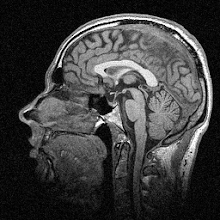Clearly we are not in conscious control of all of our actions at all times. Some reactions – like moving our hand away when we burn ourselves on a hot stove – are instinctive, reflexive. Reflexes themselves are actually a topic of hot debate in motor control these days, and there are people in my lab (including me) doing some interesting work on long-latency reflexes, which have access to some more complex processing power than the more basic, short-latency spinal reflexes that do things such as get the limb out of danger as fast as possible.
One nice example of this automaticity of behaviour is in what’s known as the double-step task. A participant reaches for a target, and during the reach the target ‘jumps’ to a different location. Without really considering what they are doing, the participant changes the reach to aim for the new target. There have been many studies that have explored various aspects of this automaticity, but the paper I’m discussing today asks the question: does stopping the automatic behaviour require more cognitive resources than letting it continue?
To investigate this question, the authors used a standard target jumping double-step task. They also tried to get participants to use up cognitive resources during the reach by giving them an auditory task to do (listen to a string of numbers and identify the pairs) at the same time. Before each trial, the participant was informed as to whether they should follow the target when it jumped (GO trials) or not to follow the target and instead reach to the original position (NOGO). The results are shown in the graph below (Figure 3 in the paper):
Movement corrections based on time from target jump
Here ‘dual task’ means that the participants were performing the reach and the cognitively demanding auditory task at the same time. The graph shows the percent of trials corrected vs. the time from the instant the target jump happens. Thus at 150 ms almost no corrections are seen, whereas after 300 ms a substantial proportion of trials have been corrected for in both conditions. The unsurprising result here is that in the GO trials there are many more corrections than in the NOGO trials overall – after all, participants were instructed to correct in the GO trials and not in the NOGO trials.
The interesting result is in the grey NOGO traces. There are substantially more corrections in the dual task than in the single task, implying that the extra cognitive load imposed in the dual task actually stopped participants from inhibiting their corrections – whereas in the black GO traces the cognitive load has no effect. This result seems to show that it actually does take cognitive effort to stop the automatic correction than letting it continue.
On the face of it this isn’t too shocking a finding. After all, if you are reacting instinctively (or in a way that reflects a high level of training) to a situation, then stopping yourself from acting that way does seem like it should take some mental effort. I know it takes mental effort for me to stop doing something extremely habitual (to quote Terry Pratchett, the strongest force in the universe is force of habit). It’s nice to see a good paper that solidifies this principle.
--
McIntosh RD, Mulroue A, & Brockmole JR (2010). How automatic is the hand's automatic pilot? Evidence from dual-task studies. Experimental Brain Research, 206 (3), 257-69 PMID: 20820760
Image copyright © Springer-Verlag 2010


No comments:
Post a Comment